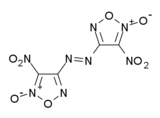4,4'-Dinitro-3,3'-diazenofuroxan
 | |
| Names | |
|---|---|
| IUPAC name
4,4’-dinitro-3,3’-diazenofuroxan | |
| Other names
DDF | |
| Identifiers | |
| Jmol-3D images | Image |
| |
| Properties | |
| C4N8O8 | |
| Molar mass | 288.092 g/mol |
| Density | 2.02 g/cm3 |
| Hazards | |
| Main hazards | Highly Explosive |
| Explosive data | |
| Detonation velocity | 10,000 m/s |
| Except where noted otherwise, data is given for materials in their standard state (at 25 °C (77 °F), 100 kPa) | |
| | |
| Infobox references | |
4,4’-Dinitro-3,3’-diazenofuroxan (DDF) is a powerful experimental high explosive with performance comparable to that of other high-density high-explosives such as octanitrocubane. It is synthesised by oxidative coupling of 4-amino-3-(azidocarbonyl)furoxan followed by Curtius rearrangement and further oxidation.[1][2]
See also
References
- ↑ Binnikov AN, Kulikov AS, Makhova NN, Ovchinnikov IV, Pivina TS. 4-Amino-3-azidocarbonyl Furoxan as an Universal Synthon for the Synthesis of Energetic Compounds of the Furoxan Series. 30th International Annual Conference of ICT, Karlsruhe, Germany, 1999. 58/1–58/10.
- ↑ Agrawal JP, Hodgson RD. Organic Chemistry of Explosives. John Wiley & Sons Ltd, 2007. p303. ISBN 978-0-470-02967-1